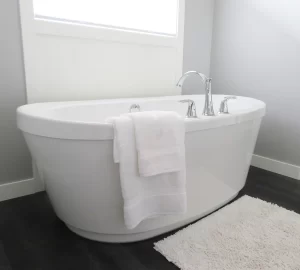How to Replace a Bathtub at Home
 Replacing a bathtub may seem like a daunting project, but with the right tools, preparation, and a little patience, it’s a manageable task for the do-it-yourselfer. Whether your old tub is cracked, outdated, or simply no longer fits in your bathroom, replacing it with a new one can significantly improve both its functionality and style.
Replacing a bathtub may seem like a daunting project, but with the right tools, preparation, and a little patience, it’s a manageable task for the do-it-yourselfer. Whether your old tub is cracked, outdated, or simply no longer fits in your bathroom, replacing it with a new one can significantly improve both its functionality and style.
Preparation and Planning
Before you begin any demolition or removal, take the time to carefully plan your project. Measure the dimensions of your existing tub and bathroom space to ensure your new tub will fit. Decide what type of tub you want—a standard alcove, freestanding, or drop-in—and make sure it’s compatible with your plumbing. Gather the necessary tools, such as a wrench, screwdriver, utility knife, pry bar, and silicone remover.
Turn off the main water
Firstly, shutt off the water supply to your bathroom. Next, remove the tub spout, faucet handles, and drain plug. You may also need to cut the water supply pipes if they are attached to the tub. Carefully disconnect the drain pipe from underneath the tub, which may require access from a crawl space or basement.
Remove the old tub
Now begin the demolition. Use a utility knife to remove any remaining grout or caulk from the edges of the tub. If the tub is surrounded by tile or drywall, you may need to remove some of it to access the flanges that hold it in place. Use a crowbar to carefully lift the tub away from the wall. Depending on the size and weight of the tub, you may need help lifting it out of the bathroom.
Prepare the space for the new tub
After removing the old tub, check the area for any signs of water damage, mold, or decay. This is a good time to repair the screed or reinforce the wall studs if necessary. Clean the area thoroughly and dry it before proceeding. Make sure the plumbing lines are in the correct position for the new tub’s fittings.
Install the new tub
Carefully move the new tub into place, making sure it fits snugly into the designated niche or space. Connect the drain and overflow and make sure everything is aligned correctly. Some tubs have adjustable feet or leveling guides; make sure the tub is level before securing it.
Seal and Finish
Once everything is connected and secured, apply a coat of waterproof sealant along the edges of the tub where it meets the wall or floor. Replace any removed tiles or panels and patch the surrounding area. Replace the faucet, spout, and drain plug. Turn the water back on and check your new tub for leaks.
Final Thoughts
Replacing a bathtub at home is a project that requires careful planning, physical effort, and attention to detail. While you can tackle the job yourself, it’s important to know your limitations, especially when it comes to plumbing or structural repairs. If you are not sure, it’s a better to contact a professional. With a successful tub replacement, you’ll not only enjoy a new, functional bathroom, but you’ll also increase the value of your home.
